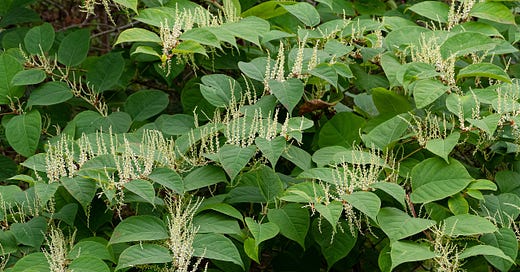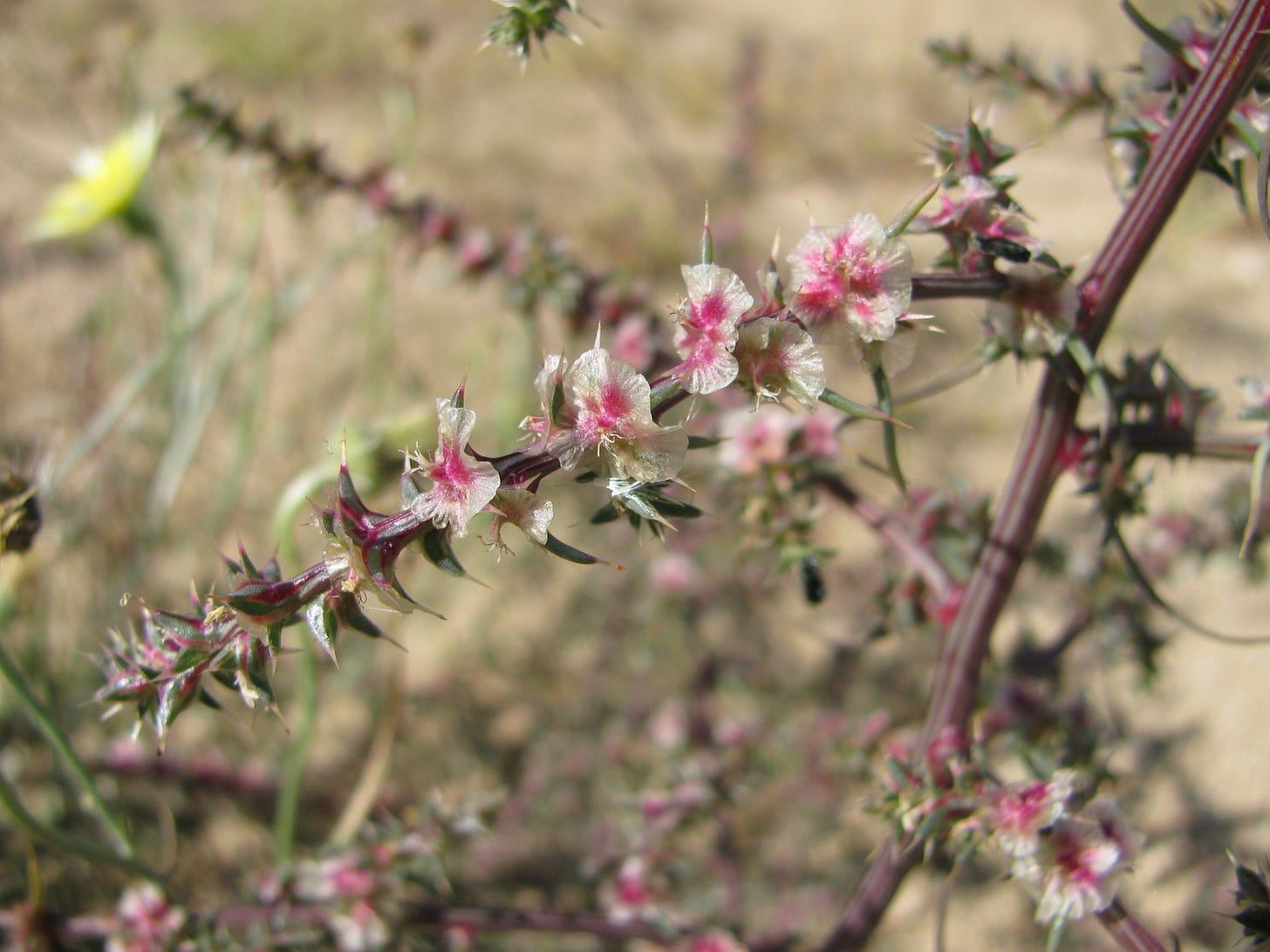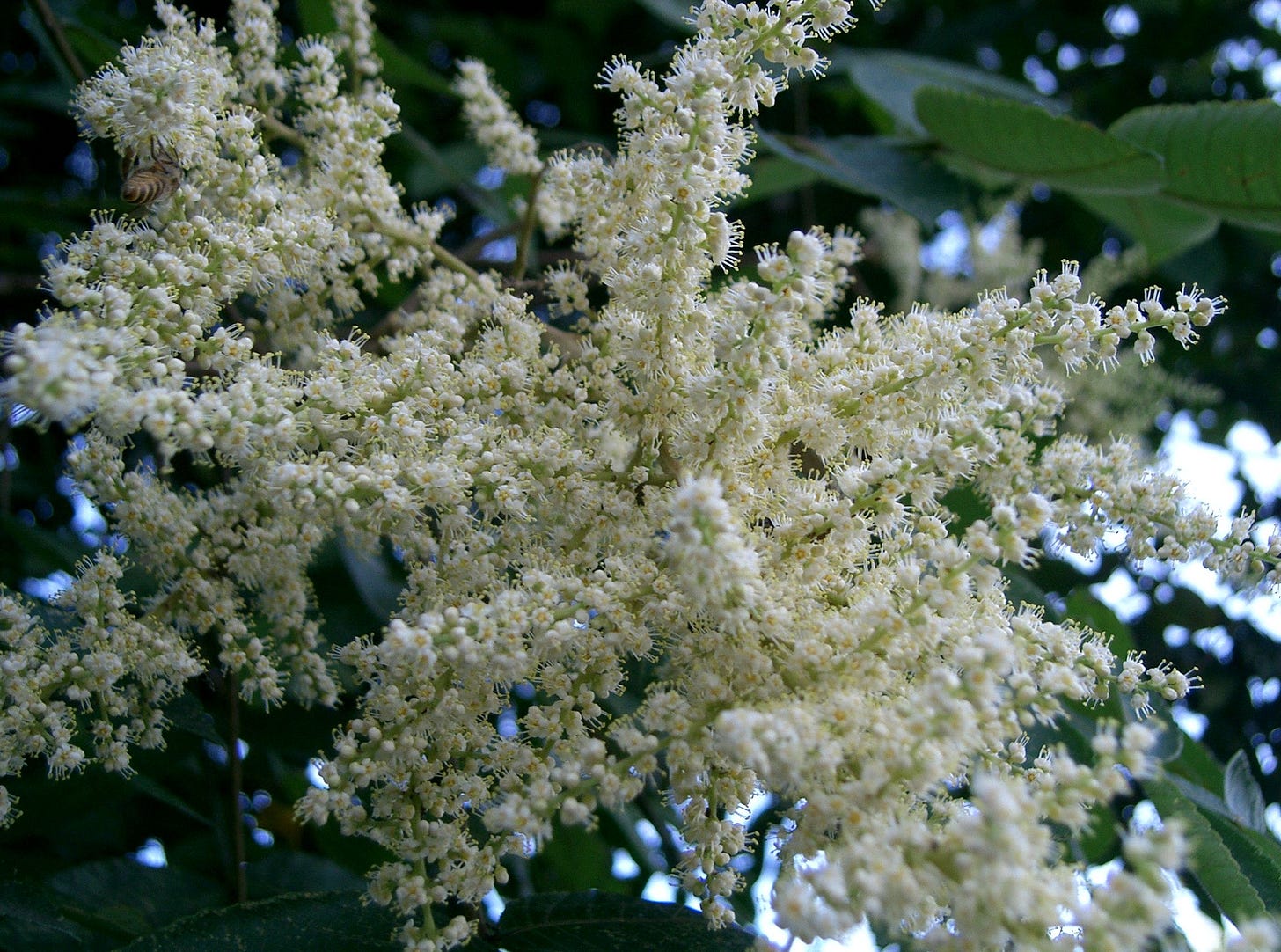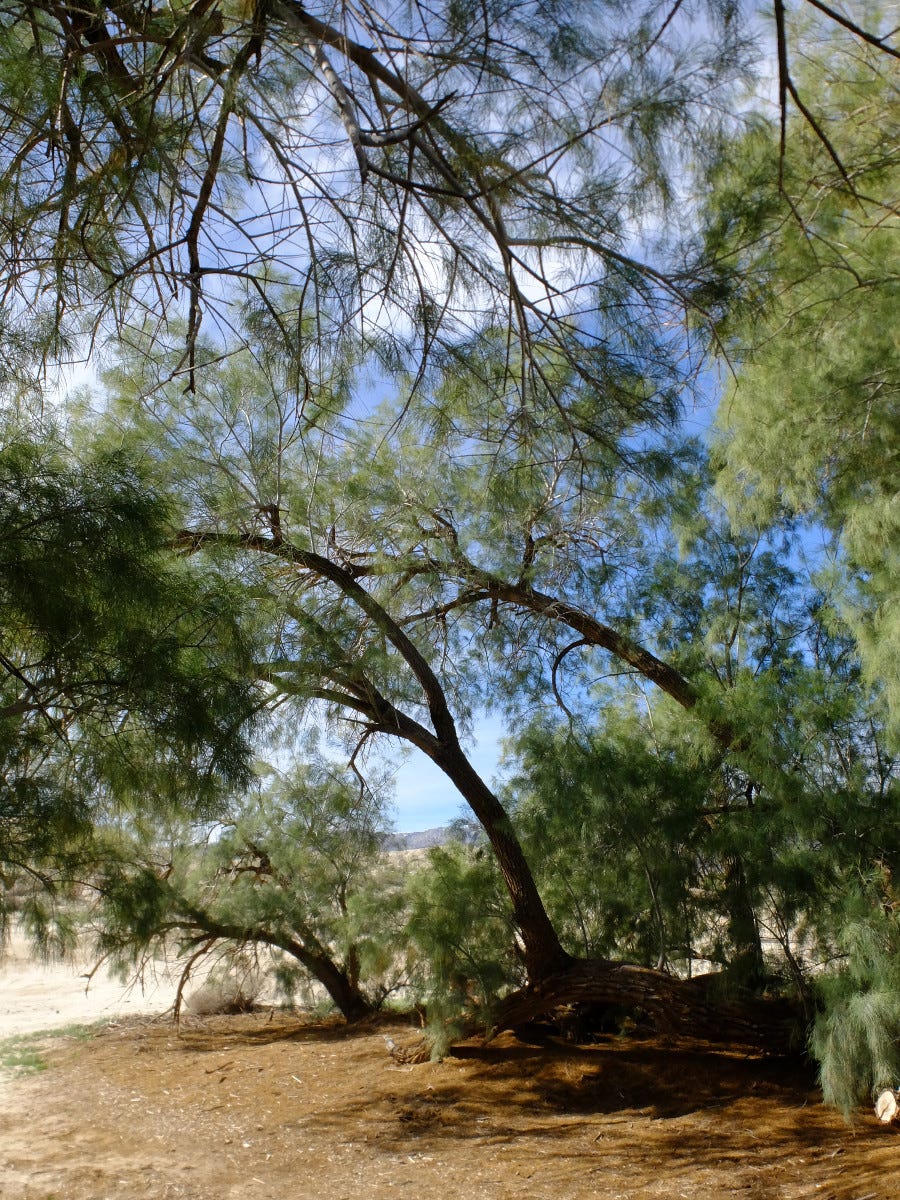Xenophobia of both anti-immigrant & "invasive species" rhetoric
An increasingly toxic atmosphere with fascist consequences
In a first this week, I am publicly posting a draft chapter from the book I am co-authoring with Nikki Hill (tentatively entitled, “Don’t Blame the Messenger: A critique of the ‘invasive plant’ narrative”). Prior to this, draft chapters have only been available to paid subscribers. I’m making an exception in this case because of how these themes relate to current events, specifically the recent kidnappings of immigrants by the Trump administration.
For context, this chapter appears in the second half of the book, at which point we have already explored the science behind various popular claims about “invasive” plants, and have demonstrated that those claims generally lack rigor and substantiation. This chapter is one among several that discuss the cultural biases and prejudices that prop up the narrative in the absence of facts.
This chapter ended up including portions of an earlier public essay, “Invasive Plants”: Immigrants who Nice People can Hate.
Those who seek funds to exclude or eradicate non-native species often attribute to them the same disreputable qualities that xenophobes have attributed to immigrant groups. These undesirable characteristics include sexual robustness, uncontrolled fecundity, low parental involvement with the young, tolerance for "degraded" or squalid conditions, aggressiveness, predatory behavior, and so on. —Mark Sagoffi
In its more extreme expressions, the rhetoric of the “invasive plant” narrative goes so far as to claim that all non-native plants are bad just for being non-native. This rigid outlook is steeped not in science—the field of invasion biology itself is far more nuanced than that—but in something else.
In the US, that something else is xenophobia, the irrational fear of the other. As a tendency in the national character it primes people to lap up feverish stories about supposedly dangerous foreigners, whether it’s the Russians, Chinese, Muslims, Communists, or immigrants. Tell US Americans that someone or something out there is out to get them, and a lot of them will believe it. Too many seemingly relish the excuse to hate and, worse yet, to kill.
As American as apple pie
An overview of xenophobia in the US includes the Chinese Exclusion Act of 1882 (alongside the local massacres and expulsions of Chinese people during the same period); the vilification of immigrants from eastern and southern Europe in the 19th and 20th Centuries; the Red Scares of WWI, the ‘50s and 20-teens; the Japanese Internment in WWII; the Islamophobia that erupted in 1979 with the Iranian hostage crisis and heightened after 9/11; and the increasingly vitriolic anti-immigrant sentiment of today,
Some apologists for these prejudices rationalize xenophobia as "instinctual" or "tribal" (yikes!) and assign it to “human nature,” but US Americans tend to universalize their unflattering qualities in order to justify them (and to avoid looking in the mirror), and as any honest anthropologist or well-seasoned overseas traveler will tell you, this assertion is bunk. While there are, and have been, cultures that are even more xenophobic than the US, many more have been less so (as anthropologists can demonstrate). As for hospitality, it was and is held in higher esteem by many other cultures (as travelers will attest). The sin of Sodom in the Bible was not homosexuality, as fundamentalist bigots spout, but the lack of hospitality shown to Lot—a guest—by the people of the town. That's how big of a deal it was to be kind to strangers; don't do it and your whole town might get smote!
The language around “invasive species” explicitly echoes anti-immigration sentiment, trotting out many of the same tropes. Recall from our chapter “A Brief History of Invasion Biology” that botanist Hewett Cottrel Watson borrowed the terms “native” and “alien” from British common law, where they applied to citizens and foreigners of the Empire, so the linguistic analogy has always been there.
Common elements of the anti-immigrant narrative include: they take jobs, commit crimes, strain government finances, and don’t assimilate. American values/culture cannot adjust to their presence without being degraded. The racist “Great Replacement” theory claims that higher rates of childbearing among immigrants as compared to European-descended people will lead to the extinction of European culture. Also bigoted (and eugenicist) is a condemnation of “miscegenation,” when a darker-skinned immigrant marries a lighter-skinned citizen. Finally, if we deport “illegals” life will improve for natural-born citizens.
And what are accusations made about “invasive plants”? They out-compete natives. They steal resources by “taking over.” Their presence costs a lot of money. They can’t change to fit in and native ecosystems can’t change to accommodate them. Some claim they reproduce faster than natives. Hybridization between native and introduced plants is denounced because it will “dilute or genetically assimilate the native genotype leaving no “pure” natives.”ii But it’s possible to get rid of them and doing so will make things better.
It’s easy to see the similarities. “Out-competes” is “taking jobs.” Both supposedly cause economic hardship. The unsupported assertion that non-native plants “reproduce faster” is a botanical Great Replacement theory. Mixing leads to a loss of purity. Et cetera. In many cases, the headlines about one could easily be read as headlines about the other.
We are not saying that the accusations about non-native plants are false because the accusations about immigrants are false (which they are).iii We’re pointing out that one narrative can “sound right” because it echoes another that’s already familiar, even when, as in this case, they’re unrelated. Neither of these two narratives—anti-immigrant and anti-“invasive”—is a good metaphor for the other, and the association is entirely misleading. But they have both proven tenacious because that’s how prejudice and social programming work.
A brief history of citizenship
In the US, the division between citizen and non-citizen boils down to place of birth in most cases. Native-born? Citizen. Foreign-born? Non-citizen. (Notwithstanding Trump’s 2025 attempt to invalidate birth-right citizenship through executive order.iv) However, citizenship was not always so simple.
In his 2015 book, "Making Foreigners: Immigration and Citizenship Law in America, 1600–2000," law professor Kunal M. Parker explains that in the past, non-citizens included both outsiders and insiders:
Over the course of American history, the impulse to regulate, reject, exclude, and remove undesirables on the grounds of race, gender, poverty, and political opinion has ranged very widely indeed. Whether at the national, state, or local level, it has driven communities to target insiders as well as outsiders. In the process, Americans have named and treated as foreigners not only those from outside the country’s borders, but also those in their very midst.v [our emphasis]
Such internal non-citizens/foreigners included, at one time or another: propertyless men, women, blacks, political dissidents and ironically, Native Americans, who clearly had the longest history of being “native-born.”
Propertyless white men had gained the right to vote in every state by 1856, and unless indigent were treated as citizens under most laws by then. Until the 20th Century, women’s citizenship in many states was essentially vicarious, derived from her husband’s under the legal concept of “coverture.” Blacks were oppressed first by enslavement and then by Jim Crow apartheid. Leftists have been imprisoned, deported, made jobless and assassinated. Native Americans suffered the worst lot of all, being subjected to genocide, land seizure and exile onto reservations. All of the above people were “native born” within the boundaries of the US but were legally denied citizenship or its benefits.
Over time, and especially with the rights movements of the 1950s onward, insiders gained the status of citizenship, at least on the law books, if not always in practice. However, the more that insiders benefited, the more alienated outsiders became. Parker puts it this way:
If the gulf between aliens and citizens, foreign-born and native-born, outsider and insider was once not terribly wide, this book argues, it has grown wider over time… As we look over the long span of American history, we see the multiple uses to which the category of “alien” has been put, not as simple reflections of the “fact” that an individual is from elsewhere, but rather as active strategies of management, control, and subordination.vi
So, though being foreign-born had always defined one as a non-citizen, the significance of that exclusion grew over time, and is greater now than it ever has been.
In the ‘90s, just as invasion biology was ramping up, US anti-immigrant sentiment and legislation was also surging. Parker again:
By the early 1990s, nativism assumed an economistic cast, focusing on the impact of immigration on the labor market, the welfare system, and the environment, but never without an unmistakable racial/cultural component...vii In 1996, Congress passed three immigration statutes... In different ways, the Acts demonstrated how the non-citizenship of resident immigrants (documented and undocumented) could be used opportunistically against them and how, under the plenary power doctrine, the gap between citizen and alien could be widened at will in ways that immigrants were powerless to contest.viii
With 9/11 came another wave of xenophobia and “invasive species” were saddled with the additional label of “terrorists”ix which is truly absurd. Terrorism is defined as act of violence by a non-state actor intended to intimidate a population or affect a government policy. Plants are even less able to commit terrorism than to “invade” but the word is effective for inciting emotion, which is the whole point. Across the board, the intensification and normalization of xenophobia since 9/11 was deep and pervasive. Those too young to remember don’t know what they missed, but many who are old enough have forgotten, which could be attributed to a kind of cultural “shifting baselines syndrome.”x
After 2016, anti-immigrant talk became increasingly bombastic. While this xenophobia was at first popularized by Donald Trump, the Republican Party and their sphere of commentators—who more and more often described illegal immigration as an “invasion”—by 2024 the Democratic Party was actively trying to outdo them on who could be the bigger hardliner on immigration issues.xi Early 2025 saw the passage by Congress of the so-called Laken Riley Act, which journalist Alec Karakatsanis characterized as “unprecedented” for its draconian provisions requiring mandatory indefinite detention and deportation of immigrants for minor charges like shoplifting.xii In March 2025, Trump invoked the Alien Enemies Act of 1798 to round up some Venezuelan immigrants and send them to a torture prison in El Salvador. (We won’t say they were “deported” because that requires a legal process that was ignored. “Kidnapped” is a more accurate word.) Trump’s justification was that the Venezuelans were allegedly members of a criminal gang whose presence here constitutes an “invasion.”xiii This claim was refuted by a federal appeals court on the grounds that an invasion is strictly a military affair, not an issue of migration, but as of this writing it remains to be seen how the conflict will resolve.xiv
An increasingly toxic atmosphere
So from the ‘90s onward there’s a correlation between expanded anti-immigrant legislation and the rise of invasion biology, with an accompanying increase in anti-immigrant and anti-“invasive” rhetoric in the media and from advocates.
Correlation is not causation, but the culture at large became more fearful, paranoid and insular during this time and these two trends were both expressions of it. Economic factors like inflation, rising personal debt, heightening wealth inequality, and a decline in the quality of labor conditions have led to increasing dissatisfaction with the status quo. These economic outcomes were the result of bipartisan neoliberal economic policy, but given the nation’s long history of xenophobia, it was easy for politicians and certain media to blame immigrants. Though liberals were less likely to buy into this story, many were susceptible to anti-”invasive species” rhetoric, in part because of an association with environmental conservation, despite the spotty scientific backing for the wild claims routinely made.
In sum. what we have are two media narratives built on misrepresentations or oversimplifications, out of spite or ignorance, which both draw on a poisoned well of bigotry. And fear, which as writer
points out, “is a pillar of fascism.” Indeed, both narratives contributed to what author Banu Subramaniam calls a “reactionary framework of bad foreigner/good native”xv Nothing good was going to come of this, and nothing has.We speculate that if the concepts of “invasion” and “invasive” had remained confined to the subject of actual warfare, and not been so recklessly applied to the non-martial movements of humans and more-than-humans alike, that Trump’s egregious misuse of the word “invasion” in his executive order would have been less possible and certainly less credible. We would go so far as to say that if progress on legal citizenship in the US is turned back, at least a small part of the blame can be laid on the thoughtless circulation of “invasive species” tropes.
And here we are, on a planet where an ever more chaotic climate will be causing more migrations as time goes on, because as the histories of both humanity and ecology show, that’s the natural and unavoidable outcome. The longer we respond with hostility, the more difficult it will be to find equitable, respectful—and realistic—solutions.
The plight of “invasive plants” is worse than human immigrants in at least one major aspect: they are denied the “path to citizenship” that humans can apply for. After all, all but the most reactionary policy makers approve of legal immigration because they recognize economic reality. For example, about 50% of agricultural laborers in the United States are undocumented migrant workers, and our food system would literally fall apart without them. Culturally, outsiders can become insiders, as with the Irish, who faced “No Irish need apply” signs in the mid-1800s, but who were eventually allowed into the mainstream and rose into the elite alongside other Europeans. So, too, we must admit that many introduced and “invasive” plants have become naturalized here, and that native animals, birds and insects are now dependent on them. If, overnight, we deported every human immigrant and eradicated every “invasive” plant, immense suffering and death would result.
But for introduced plants there is no way to become native, because the designation is based on a Gregorian calendar date, full stop. They will forever be outsiders, no matter how long they are here and how much they integrate into native ecosystems. As we mentioned, such dogmas have hazards.
A lesson from Mother Nature
But what about when, by way of age-old, recognized processes of speciation like genetic divergence or hybridization, a species transforms enough to become a new species? One possible example involves the genus of trees, Tamarix, known as Saltcedar or Tamarisk (see our earlier chapter). Biologist Matt Chew writes:
Three species (T. chinensis, T. ramosissima, T. aphylla) not known to hybridize where their Old World ranges overlap are doing so in the USA, producing unprecedented, fertile hybrids. These lines may constitute new species; hypothetical Tamarix americana* (a taxonomist’s asterisk) paradigmatically native because they evolved within their current ranges and endemic because they exist nowhere else.xvi
In other words, a newly emerged hybrid of multiple introduced species is fulfilling at least two fundamental characteristics of what constitutes a “native” species: that it evolved in a particular area and that it is found nowhere else. With Tamarix, Mother Nature is complicating our binary, and challenging our “no path to citizenship.” Good for her! We deserve to be humbled. If we’re smart, we’ll take this and her other lessons to heart and reform ourselves, our unhealthy attitudes, and our malign policies.
Subramaniam advises: “Rather than foster xenophobia, we should challenge native and foreign as labels for humans and plants. We need new vocabularies and new stories to narrate life on earth.” [emphasis in original]









It was so brilliant to link invasive species with immigrants!
In each case, there is a niche to fill. It isn't the plant's (or the immigrant's) fault.
Case in point: in the Pacific Northwest, we have a Scotch Broom infestation that people hate with a passion. Perhaps it's because it is so beautiful when in bloom in June. Perhaps it's because it spreads multiple ways, and pulling it up only works for a short time.
But *I* know how to get rid of it! QUIT CLEARING LAND!
It's a classic "pioneer species", specialized by nature to repair disturbed areas. It won't grow in a native forest, but only around the edges.
With our roads, fields, and parks, we've created a huge habitat for pioneer species. As with human immigrants, the natives are not up to the task, having evolved in an era without so much disturbance. So they move in. It's totally false that invasive immigrants displace the natives — they're doing a job that natives cannot or will not do!
If I didn't think I'd get lynched, I'd plant the stuff for my goats!
It's a nitrogen fixer that has as much protein as alfalfa, but with a significant tannin load — a tasty vermifuge! After the goats have had their way with the foliage, I chipped the woody remains and spread it on paths and between rows to suppress weeds. (Don't mulch desired plants with it!)
But I didn't have to plant it.
Instead, I contacted "do gooder" non-profit organizations. They would hold "work parties" and go out and pull it up with a vengeance. But it is highly flammable, and they couldn't just leave it in piles — so I got them to deliver it directly to my goat feeders!
After I started doing this, I never had to use chemical wormers on my goats.
Some day, after humans are gone, fields and roadsides will go through succession, resulting in restoring a climax species, and the Scotch Broom will be gone. But I won't be around to miss it.
A powerful chapter, with a loud crescendo to bring the parallels between the two discourses to light. It's definitely timely and right on.